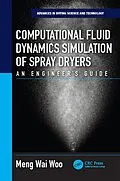Bridging the gap in understanding between the spray drying industry and the numerical modeler on spray drying, Computational Fluid Dynamics Simulation of Spray Dryers: An Engineer's Guide shows how to numerically capture important physical phenomena within a spray drying process using the CFD technique. It includes numerical strategies to effectively describe these phenomena, which are collated from research work and CFD industrial consultation, in particular to the dairy industry. Along with showing how to set up models, the book helps readers identify the capabilities and uncertainties of the CFD technique for spray drying. After briefly covering the basics of CFD, the book discusses airflow modeling, atomization and particle tracking, droplet drying, quality modeling, agglomeration and wall deposition modeling, and simulation validation techniques. The book also answers questions related to common challenges in industrial applications.
Autorentext
Meng Wai Woo is currently a senior lecturer of chemical engineering at Monash University, Australia. His research interest is in spray drying. He has experience in computational fluid dynamics (CFD) analysis of the spray drying process and in applying this technique for industry. Within the area of spray drying, he is also examining the droplet evaporation, particle formation or interaction phenomena and in engineering the functionality of particles. Dr. Woo also explores new approaches to spray drying in introducing the antisolvent vapor precipitation approach and most recently, the narrow tube spray drying technique.
Inhalt
Chapter 1 Introduction
1.1 Why Do We Need CFD Simulation of Spray Drying?
1.2 Components of CFD Simulation of Spray Drying
Chapter 2 Basics of CFD
2.1 How Are Those Velocity and Temperature Plots Generated?
2.2 How is Turbulence Captured?
2.3 Common Basic Numerical Strategies
Chapter 3 Airflow Modeling
3.1 Turbulence Model Selection
3.2 Transient Flow versus Steady Flow
3.2.1 In What Situations Do We Expect Transient Flows?
3.2.2 Important Numerical Strategies for Transient Flows
Chapter 4 Atomization and Particle Tracking
4.1 Capturing Rotating Atomization
4.2 Capturing Pressure-Based Atomization
4.3 Simulating Particles Transport by Convection and Dispersion
4.4 Important Numerical Strategies in Two-Way Coupling
Chapter 5 Droplet Drying and Quality Modeling
5.1 How is Drying Captured in the Particle-in-Cell Approach?
5.2 Comparison on the Existing Models
5.2.1 Characteristic Drying Curve
5.2.2 Reaction Engineering Approach
5.2.3 Comparison between the CDC and the REA Approach
5.3 How is the Drying Kinetics Measured for Specific Products?
5.4 Effect of Accurately Capturing the Particles Shrinkage and its Implications
5.5 A Note on Mass and Heat Transfer Coefficients
5.6 Incorporation of Quality Modeling of the Particles
Chapter 6 Agglomeration and Wall Deposition Modeling
6.1 Predicting the Collision Efficiency for Agglomeration Application
6.2 Modeling Stickiness and Coalescence
6.2.1 Sticking Criterion
6.2.2 Important Experiments to Measure the Stickiness of Particles
6.3 Predicting the Structure of the Agglomerate
6.4 Capturing the Near Wall Phenomenon for Wall Deposition
6.4.1 Momentum Impact versus Diffusion Impact
6.4.2 Modeling Particle Removal Due to Shearing
Chapter 7 Simulation Validation Techniques
7.1 Airflow Measurements
7.2 Temperature and Humidity Measurements
7.3 Yield, Product, and Deposition Flux Measurements
7.4 Controlled Experimental Technique for Model Development
Chapter 8 Common Challenges for Industrial Applications
8.1 Managing Expectations
8.1.1 Estimation of Droplet Size for Atomization of Concentrated Feed
8.1.2 Complex and Lack of Information on Air Inlet Configurations
8.1.3 Is the Spray Dryer Well Insulated?
8.1.4 How Do CFD Simulations Tie in With Plant-Wide Prediction Packages?
8.1.5 I Want to Understand Why My New Spray-Dried Formulation is Off-Specification!
8.1.6 How Does the CFD Model Reflect My Actual Feed Material?
8.1.7 Strategy for Outlet-Controlled Spray Dryers?
8.1.8 How Accurate is the Final Particle Moisture Content Prediction?
References
Index
